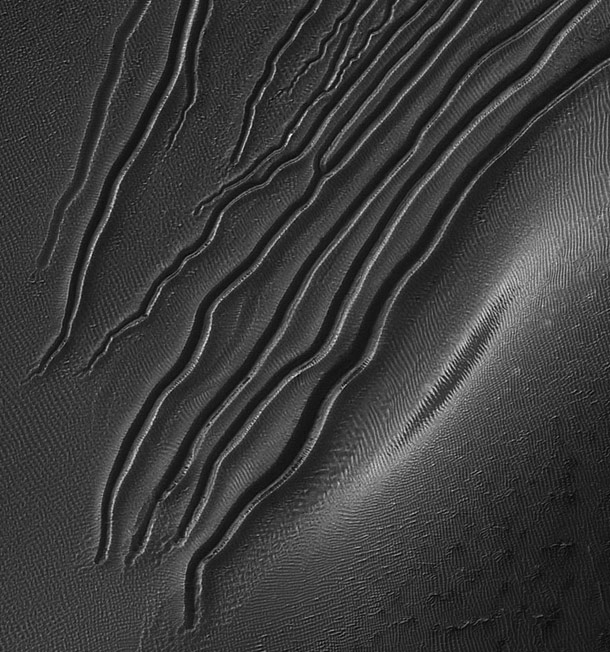The idea of liquid water on Mars is an enticing one. We know life on Earth needs liquid water, and if we find it on Mars… We know there’s plenty of frozen water on Mars; we see it there in abundance. But Mars is cold, and the air is thin, making liquid water on the surface difficult to achieve, let alone sustain.
But there’s been tantalizing evidence. Ever since Mars Global Surveyor got to the Red Planet in 1997, we’ve seen gullies sprinkled here and there. These gullies form on slopes near the tops of the hills, and are clearly the result of something moving downslope and digging furrows. But is that something water, or just sand and dust? The conclusions flip-flop back and forth; I’ve seen papers come out saying water-not-sand and others saying sand-not-water several times.
 A new paper has just come out saying it’s sand and dust, and not water, that’s doing the trick. The authors did a clever experiment. They assumed that it was dry ice – frozen carbon dioxide – that was behind the gullies, and not water. As the dry ice turns into a gas in warmer weather, they supposed, it blows out of the ground and gets in between the sand particles, causing them to run downslope like a fluid. That’s a fair assumption, given how common dry ice is on Mars. They then set up a tub filled with Mars-like sand, piled it into a slope, and used an air pump to force air under the sloping pile. Sure enough, the sand flowed down, making gullies that seem very much like what’s seen on Mars!
A new paper has just come out saying it’s sand and dust, and not water, that’s doing the trick. The authors did a clever experiment. They assumed that it was dry ice – frozen carbon dioxide – that was behind the gullies, and not water. As the dry ice turns into a gas in warmer weather, they supposed, it blows out of the ground and gets in between the sand particles, causing them to run downslope like a fluid. That’s a fair assumption, given how common dry ice is on Mars. They then set up a tub filled with Mars-like sand, piled it into a slope, and used an air pump to force air under the sloping pile. Sure enough, the sand flowed down, making gullies that seem very much like what’s seen on Mars!
Here’s one of their experimental results (left) compared to Mars (right). You can see a lot of the gross features are very similar. Their idea also naturally explains why these gullies form mostly at mid-latitudes: closer to the equator it doesn’t get cold enough to make much frozen CO2, and closer to the poles it never gets warm enough to turn to gas and drive the sand flows. And their experiments do reproduce a lot of the features of the actual Martian gullies…
A lot, but not all. As I wrote a few weeks ago, new observations of some gullies show peculiar features. One of the most provocative is that the trenches carved by the moving material don’t fan out as you might expect at their downslope terminals – look at the image at the top of this post to see what I mean (and click it to embiggen it most cromulently; it’s beautiful). As I said in that post, “They just kinda stop.” Flowing sand tends to spread out, or form a raised feature at a trench terminus. But these new gullies simply don’t do that. That does seem to point to some other material driving the motion. Water? Maybe.
There are still problems with the idea of water; if it erupts out to form some of these gullies, how does it get resupplied? In the paper, they note that CO2 will freeze out of the air on Mars, so the supply is re-established. Water, not so much. It hasn’t rained on Mars in a billion years. However, an underground aquifer of some sort isn’t a totally crazy idea.
So clearly there are issues with both ideas, just as both ideas have their strong points as well. But I wonder… are we seeing more than one process here? After all, there’s no rule that says all gullies must form the same way, and the different morphologies (structures and shapes) hint that perhaps different mechanisms are at work on Mars.
I know a way we can find out: send more probes. Lots of probes. Because while I love a mystery as much as the next scientist, another thing I love is answers. Mars is Ellery Queen, Agatha Christie, and Scooby Doo all rolled into one big red ball. The clues are tantalizing, the evidence is scattered, but dagnappit, the answers are lying right there on the surface.
All we have to do is go there and flip to the last page.
Tip o’ the sandworm to Emily at The Planetary Society Blog for the image, which is from HiRISE. I found out about the new research from Slashdot.